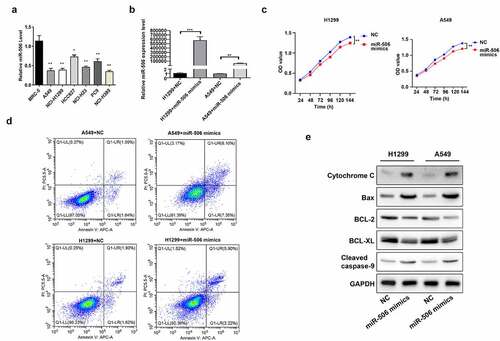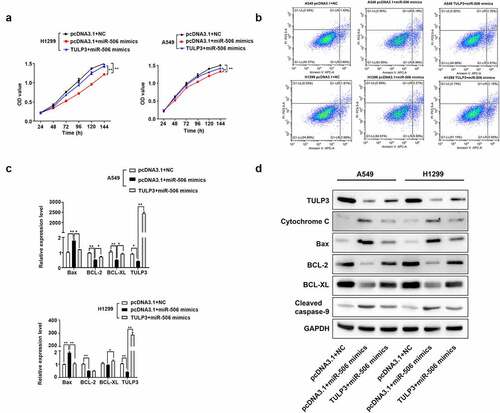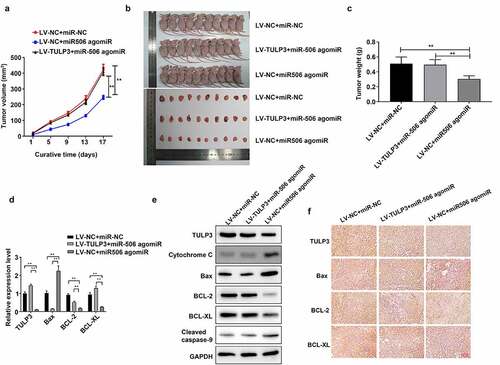Figures & data
Table 1. Primer sequences used in this study
Figure 1. MiR-506 suppresses viability and enhances mitochondrial apoptosis of nonsmall-cell lung cancer cells. (a). miR-506 expression level in different cell lines. (b). Relative miR-506 expression level when cells were transfected with miR-506 mimics. (c). Cell viability detected using 3-(4,5-dimethylthiazol-2-yl)-5-(3-carboxymethoxyphenyl)-2-(4- sulfophenyl)-2 H-tetrazolium assay in H1299 and A549 cells. (d). Overexpression of miR-506 enhanced cell apoptosis in H1299 and A549 cells. (e). Western blotting used to determine the protein level of cytochrome C, Bax, BCL-2, BCL-XL, and cleaved caspase-9 in miR-506 mimics-transfected H1299 and A549 cells

Figure 2. Tubby-like protein 3 is a target gene of miR-506. (a). Tubby-like protein 3 (TULP3) exhibited is a potential target gene of miR-506 in the prediction. (b). Real-time quantitative polymerase chain reaction results suggest that TULP3 expression is downregulated under the effect of miR-506 mimics. (c). Western blotting was used to detect protein level of TULP3. (d). Dual-luciferase assay proved that TULP3 is the directly target gene of miR-506

Figure 3. Tubby-like protein 3 silencing prevents viability and aggrandizes mitochondrial apoptosis of nonsmall-cell lung cancer cells. H1299 and A549 cells were transfected with tubby-like protein 3 (TULP3) siRNAs and siRNA-negative control (siRNA-NC), respectively. (a). Cell viability was assessed by 3-(4,5-dimethylthiazol-2-yl)-5-(3-carboxymethoxyphenyl)-2-(4- sulfophenyl)-2 H-tetrazolium assay. (b). Cell apoptosis was verified using flow cytometry. (c). Real-time quantitative polymerase chain reaction analysis of TULP3, Bax, BCL-2, and BCL-XL. (d). Western blotting of TULP3, cytochrome C, Bax, BCL-2, BCL-XL, and cleaved caspase-9 expressions

Figure 4. MiR-506 depresses nonsmall-cell lung cancer progression by tubby-like protein 3. (a). 3-(4,5-dimethylthiazol-2-yl)-5-(3-carboxymethoxyphenyl)-2-(4- sulfophenyl)-2 H-tetrazolium assay was used to determine cell viability for the cells H1299 and A549 under the treatment of miR-506 mimics and tubby-like protein 3 (TULP3) overexpression vector. (b). Flow cytometry to determine the cell apoptosis under the treatments of overexpression of miR-506 and TULP3. (c). Real-time quantitative polymerase chain reaction was used to determine the mRNA level of the cell apoptosis-related genes under the treatments of overexpression of miR-506 and TULP3. (d). Western blotting was used to determine the protein levels of mitochondrial apoptosis-related proteins under the treatments of overexpression of miR-506 and TULP3

Figure 5. MiR-506 restrains growth and induces mitochondrial apoptosis in the mice xenograft model of nonsmall-cell lung cancer. (a). Tumor volume under the effect of tubby-like protein 3 (TULP3) and miR-506 overexpression. (b). Photographs of the nude mice and tumors under the effect of TULP3 and miR-506 overexpression. (c). The miR-506 agomiR reduced the weight of the tumor, but the overexpression of TULP3 reversed this effect. (d). Real-time quantitative polymerase chain reaction was used to determine the mRNA levels of TULP3 and apoptosis-related genes under the treatments of overexpression of miR-506 and TULP3. (e). Western blotting was used to determine the levels of TULP3, mitochondrial apoptosis-related proteins under the treatments of overexpression of miR-506 and TULP3. (f). Immunohistochemical staining was used to determine the protein level of the cell apoptosis-related protein under the treatments of overexpression of miR-506 and TULP3

Data availability
The data that support the findings of this study are available from the corresponding author upon reasonable request.
